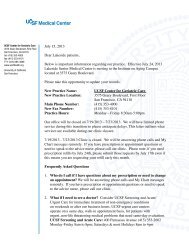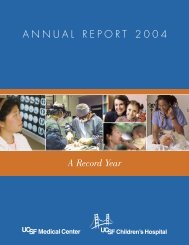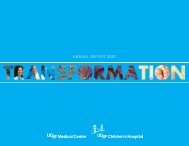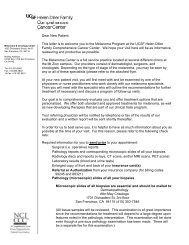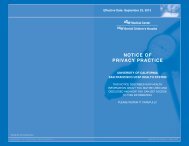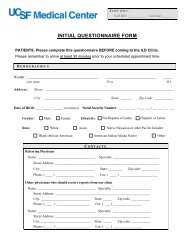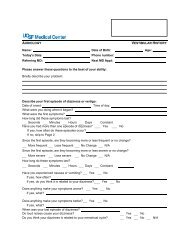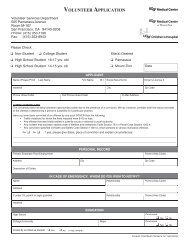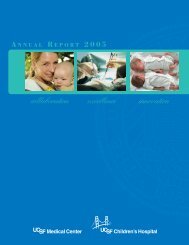c e n t e r n e w s l e t t e r - UCSF Medical Center
c e n t e r n e w s l e t t e r - UCSF Medical Center
c e n t e r n e w s l e t t e r - UCSF Medical Center
Create successful ePaper yourself
Turn your PDF publications into a flip-book with our unique Google optimized e-Paper software.
Using Information Technology to Streamline Care<br />
By Ed Mahoney and Laura Esserman, MD<br />
A wealth of data is generated at health care institutions such as <strong>UCSF</strong>, but it is often difficult for doctors<br />
and researchers to easily analyze this information to improve patient care. The data is typically stored in<br />
a form that makes posing even the simplest research questions a significant undertaking. Our <strong>Center</strong> of<br />
Excellence Program is developing a software application that will remedy this situation by using modern<br />
relational database technology to store information in a form that can be easily queried for clinical care.<br />
We are designing tools that can be used at the point of care to collect information and an infrastructure that<br />
provides a means to aggregate data in a matter of seconds for the whole population we care for. Eventually<br />
we believe this will offer a whole new way of collecting, gathering and analyzing information on all women<br />
with breast cancer.<br />
Using a suite of tools called the Communication and Care Plan, we are compiling the most critical<br />
information for women with breast cancer: the list of their biopsies, surgical procedures and pathology<br />
results.<br />
The pathology part of the application, which is being developed by a multidisciplinary team of<br />
surgeons, pathologists, the cancer registry and software engineers, provides three main benefits to<br />
the Breast Care <strong>Center</strong>.<br />
• The data is entered using a series of Web-based forms that allow the user to enter information<br />
easily and logically, providing more protection against error.<br />
• A summary report is produced from the entered data, which can be used by surgeons and oncologists<br />
to provide better care for patients after they undergo cancer surgery. Important information<br />
a provider needs to make patient care decisions is presented in a clear and concise manner, with<br />
the most critical information listed first. This summary information will then always be available<br />
for providers and patients alike.<br />
• The pathology application includes a query system that allows the researcher to ask questions,<br />
producing a result in seconds, when previously it could take weeks of manual effort to get the<br />
same information. This query system can be used for many purposes, from identifying patient<br />
populations that require follow-up care to providing quality improvement information to see<br />
if changes in clinical procedures are having a noticeable effect on patient results.<br />
All of this information is protected by a secure authentication system so that patient privacy<br />
is respected.<br />
Initially, this system will improve care by making critical information readily available to health<br />
providers during treatment. But as more and more data is collected, we will find ways to use this<br />
information to explore many aspects of cancer diagnosis and treatment. Like the Survivorship<br />
Program highlighted on the cover of this newsletter, this software system is part of a comprehensive<br />
effort to change the way we gather and use information to improve patient care. Look for<br />
updates about this program in our next newsletter.<br />
BREAST CARE CENTER NEWSLETTER • SPRING 2008 • page 6





